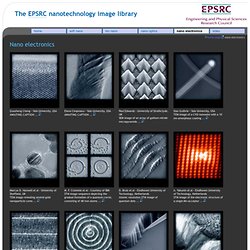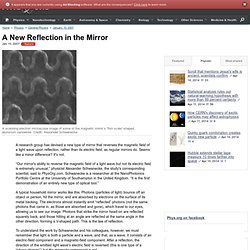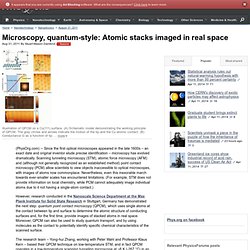

I.B.M. Researchers Create High-Speed Graphene Circuits. The I.B.M. advance, which the researchers reported in the journal Science, is a circuit known as a broadband frequency mixer that was built on a wafer of silicon.

Widely used in all kinds of communications products, the circuits shift signals from one frequency to another. In the Science paper, the I.B.M. researchers describe a demonstration in which they deposited several layers of graphene on a silicon wafer, then created circuits based on graphene transistors and components known as inductors. Nano electronics; new devices and incremental nanotechnology. Guosheng Cheng - Yale University, USA AWAITING CAPTION ...

Elena Cimpoiasu - Yale University, USA AWAITING CAPTION ... Nanotechnological innovations can improve water purification. Research teams are trying different approaches within the nanotechnological field to improve water membrane technologies.

One of these is to improve water purification by using nature’s own water-transporting channels, aquaporins. However, constructing suitable membranes for industrial processes is a challenge. Membranes for water purification are used in many applications and different types of membranes are being developed at the moment. Nanotechnology News - Nanoscience, Nanotechnolgy, Nanotech News. Silver bits channel nano light TRN 042303. Computer circuits and nanodevices are already smaller than that, and getting still smaller.

The key is figuring out how to guide near-field light, which forms a standing field rather than light's usual moving wave. Near-field light is produced by shining light through a tiny hole or lens that is positioned closer to a surface than the wavelength of the light; its size is limited by the hole or lens size rather than the wavelength of the light. When light is farther away from a surface, it can only be focused to about half its wavelength. Researchers from the California Institute of Technology and the University of Southern California have found a way to guide near-field light over short distances through channels that are several times narrower than the wavelengths of light.
The method sets the stage for nanoscale sensors and communications devices that use light to measure individual molecules and carry signals between tiny, closely spaced electronic components. Nanoscope peers beyond the limits of light. A New Reflection in the Mirror. A research group has devised a new type of mirror that reverses the magnetic field of a light wave upon reflection, rather than its electric field, as regular mirrors do.

Seems like a minor difference? It's not. “Our mirror's ability to reverse the magnetic field of a light wave but not its electric field is extremely unusual,” physicist Alexander Schwanecke, the study's corresponding scientist, said to PhysOrg.com. Schwanecke is a researcher at the NanoPhotonics Portfolio Centre at the University of Southampton in the United Kingdom. “It is the first demonstration of an entirely new type of optical tool.”
A typical household mirror works like this: Photons (particles of light) bounce off an object or person, hit the mirror, and are absorbed by electrons on the surface of its metal backing. This magnetic mirror produces the opposite scenario: a flipped magnetic field and an unchanged electric field. InContext Modules. Writing Circuits on Graphene. Using a heated atomic force microscope tip, researchers have drawn nanoscale conductive patterns on insulating graphene oxide.

This simple trick to control graphene oxide’s conductivity could pave the way for etching electronic circuits into the carbon material, an important advance toward high-speed, low-power, and potentially cheaper computer processors. Graphene, an atom-thick carbon sheet, is a promising replacement for silicon in electronic circuits, since it transports electrons much faster. IBM researchers have already made transistors, the building blocks of electronic circuits, with graphene that work 10 times faster than their silicon counterparts. 'Bacterial nanowires' could revolutionise bioelectronics. A bacterium called Geobacter sulfurreducens contains microbial nanowires that can efficiently transmit electricity, holding great promise for nanotechnology and bioelectronics.

A team of physicists and microbiologists at the University of Massachusetts says their dicovery could lead to cheaper, nontoxic nanomaterials for biosensors and solid state electronics that interface with biological systems. Lead microbiologist Derek Lovley says the bacterial filaments, known as microbial nanowires, can move charges as efficiently as synthetic organic metallic nanostructures - and over remarkable distances, thousands of times the bacterium's length. "The ability of protein filaments to conduct electrons in this way is a paradigm shift in biology and has ramifications for our understanding of natural microbial processes as well as practical implications for environmental clean-up and the development of renewable energy sources," says Lovley.
Atomic stacks imaged in real space. (PhysOrg.com) -- Since the first optical microscopes appeared in the late 1600s – an exact date and original inventor elude precise identification – microscopy has evolved dramatically.

Scanning tunneling microscopy (STM), atomic force microscopy (AFM) and (although not generally recognized as an established method) point contact microscopy (PCM) allow scientists to view objects inaccessible to optical microscopes, with images of atoms now commonplace. Nevertheless, even this inexorable march towards ever-smaller scales has encountered limitations. (For example, STM does not provide information on local chemistry, while PCM cannot adequately image individual atoms due to it not having a single-atom contact.) The 10 strangest facts about graphene. When first discovered, graphene was odd.

Now odd is too small a word for a material seemingly set on winning all the records a material can win. In the first part of our series, we looked at what graphene is and how it was discovered. In part two, we explored the different techniques we can use to make graphene. Nanotechnology Desktop Factory.